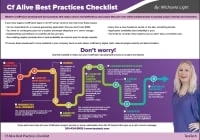Raymond Camden talks about “Kick Your Server to the Curb and Go Serverless” in this episode of ColdFusion Alive Podcast, with host Michaela Light. Raymond is a developer advocate for IBM. His work focuses on LoopBack, API Connect, serverless, hybrid mobile development, Node.js, HTML5, and web standards in general. He's a published author and presents at conferences and user groups on a variety of topics.
“I look at my history of building websites of ColdFusion, and I see a lot of cases where I could have, and not all the time, but I could have replaced it with something a little bit simpler, like Serverless.” – Raymond Camden
Show notes
Mentioned in this episode
- OpenWhisk
- Serverless
- My Cloud
- Node.js
- REST
- Bluemix
- Watson services
- IBM
- Apache
- PhoneGap
- Lucee CFML
- CommandBox
- 025 Why Programming in Node is so Powerful (how CFers can learn), with Ray Camden
- 073 Progressive Web Apps (A Gentle Intro for CFers who are scared of PWAs) with Ray Camden
Listen to the Audio
Bios
Raymond Camden
Raymond is one of the speakers for the upcoming Into The Box ColdFusion Conference, where he will talk about going Serverless.
Links
Interview transcript
Michaela Light: Welcome back to The Box interviews. I'm here with Ray Camden, developer advocate for IBM, and a long time fan of ColdFusion, and he's speaking on, what are you speaking on, Ray? It sounded like a very interesting topic about OpenWhisk.
Raymond Camden: Yeah. So I'm speaking about Serverless with Apache OpenWhisk, which is a project that IBM is heavily involved with, as well.
Michaela Light: And for those who haven't understood what OpenWhisk is, because it sounds like, from what I've read, it could do a number of things. Some of which are incredibly powerful. Ray, what exactly is it?
Raymond Camden: Let me back up and talk about Serverless first, because I kind of avoided the topic for a while myself, because I knew the name was kind of stupid, and even more so than My Cloud, you know, Serverless, I knew, was the exact opposite, unless they were running on imaginary numbers, or something, but the best way to think of it is function as a service.
And to continue learning how to make your ColdFusion apps more modern and alive, I encourage you to download our free ColdFusion Alive Best Practices Checklist.
Because… perhaps you are responsible for a mission-critical or revenue-generating CF application that you don’t trust 100%, where implementing new features is a painful ad-hoc process with slow turnaround even for simple requests.
What if you have no contingency plan for a sudden developer departure or a server outage? Perhaps every time a new freelancer works on your site, something breaks. Or your application availability, security, and reliability are poor.
And if you are depending on ColdFusion for your job, then you can’t afford to let your CF development methods die on the vine.
You’re making a high-stakes bet that everything is going to be OK using the same old app creation ways in that one language — forever.
All it would take is for your fellow CF developer to quit or for your CIO to decide to leave the (falsely) perceived sinking ship of CFML and you could lose everything—your project, your hard-won CF skills, and possibly even your job.
Luckily, there are a number of simple, logical steps you can take now to protect yourself from these obvious risks.
No Brainer ColdFusion Best Practices to Ensure You Thrive No Matter What Happens Next
ColdFusion Alive Best Practices Checklist
Modern ColdFusion development best practices that reduce stress, inefficiency, project lifecycle costs while simultaneously increasing project velocity and innovation.
√ Easily create a consistent server architecture across development, testing, and production
√ A modern test environment to prevent bugs from spreading
√ Automated continuous integration tools that work well with CF
√ A portable development environment baked into your codebase… for free!
Learn about these and many more strategies in our free ColdFusion Alive Best Practices Checklist.

Michaela Light is the host of the CF Alive Podcast and has interviewed more than 100 ColdFusion experts. In each interview, she asks "What Would It Take to make CF more alive this year?" The answers still inspire her to continue to write and interview new speakers.
Michaela has been programming in ColdFusion for more than 20 years. She founded TeraTech in 1989. The company specializes in ColdFusion application development, security and optimization. She has also founded the CFUnited Conference and runs the annual State of the CF Union Survey.

